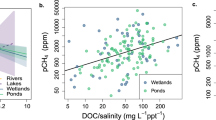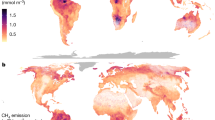Abstract
Inland waters are an important component of the global carbon cycle. Although they contribute to greenhouse gas emissions1,2,3,4,5, estimates of carbon processing in these waters are uncertain. The global extent of very small ponds, with surface areas of less than 0.001 km2, is particularly difficult to map, resulting in their exclusion from greenhouse gas budget estimates. Here we combine estimates of the lake and pond global size distribution, gas exchange rates, and measurements of carbon dioxide and methane concentrations from 427 lakes and ponds ranging in surface area from 2.5 m2 to 674 km2. We estimate that non-running inland waters release 0.583 Pg C yr−1. Very small ponds comprise 8.6% of lakes and ponds by area globally, but account for 15.1% of CO2 emissions and 40.6% of diffusive CH4 emissions. In terms of CO2 equivalence, the ratio of CO2 to CH4 flux increases with surface area, from about 1.5 in very small ponds to about 19 in large lakes. The high fluxes from very small ponds probably result from shallow waters, high sediment and edge to water volume ratios, and frequent mixing. These attributes increase CO2 and CH4 supersaturation in the water and limit efficient methane oxidation. We conclude that very small ponds represent an important inland water carbon flux.
This is a preview of subscription content, access via your institution
Access options
Subscribe to this journal
Receive 12 print issues and online access
$259.00 per year
only $21.58 per issue
Buy this article
- Purchase on Springer Link
- Instant access to full article PDF
Prices may be subject to local taxes which are calculated during checkout


Similar content being viewed by others
Change history
09 February 2016
In the original version of this Letter published online, the scale of the x axis in panels a, c and e in Fig. 1 did not extend over the full data range, and as a result three data points were omitted from each panel. In addition, all instances of 'Supplementary Methods' and 'Supplementary References' have been changed to 'Supplementary Information'. This has been corrected in all versions of the Letter.
References
Cole, J. J. et al. Plumbing the global carbon cycle: integrating inland waters into the terrestrial carbon budget. Ecosystems 10, 172–185 (2007).
Raymond, P. A. et al. Global carbon dioxide emissions from inland waters. Nature 503, 355–359 (2013).
Aufdenkampe, A. K. et al. Riverine coupling of biogeochemical cycles between land, oceans, and atmosphere. Front. Ecol. Environ. 9, 53–60 (2011).
Tranvik, L. J. et al. Lakes and reservoirs as regulators of carbon cycling and climate. Limnol. Oceanogr. 54, 2298–2314 (2009).
Regnier, P. et al. Anthropogenic perturbation of the carbon fluxes from land to ocean. Nature Geosci. 6, 597–607 (2013).
Maybeck, M. in Physics and Chemistry of Lakes (eds Lerman, A., Imboden, D. M. & Gat, G. R.) 1–36 (Springer, 1995).
Lehner, B. & Döll, P. Development and validation of a global database of lakes, reservoirs and wetlands. J. Hydrol. 296, 1–22 (2004).
Downing, J. A. et al. The global abundance and size distribution of lakes, ponds, and impoundments. Limnol. Oceanogr. 51, 2388–2397 (2006).
McDonald, C. P., Rover, J. A., Stets, E. G. & Striegl, R. G. The regional abundance and size distribution of lakes and reservoirs in the United States and implications for estimates of global lake extent. Limnol. Oceanogr. 57, 597–606 (2012).
Seekell, D. A., Pace, M. L., Tranvik, L. J. & Verpoorter, C. A fractal-based approach to lake size-distributions. Geophys. Res. Lett. 40, 517–521 (2013).
Verpoorter, C., Kutser, T., Seekell, D. A. & Tranvik, L. J. A global inventory of lakes based on high-resolution satellite imagery. Geophys. Res. Lett. 41, 6396–6402 (2014).
Kortelainen, P. et al. Sediment respiration and lake trophic state are important predictors of large CO2 evasion from small boreal lakes. Glob. Change Biol. 12, 1554–1567 (2006).
Kankaala, P., Huotari, J., Tulonen, T. & Ojala, A. Lake-size dependent physical forcing drives carbon dioxide and methane effluxes from lakes in a boreal landscape. Limnol. Oceanogr. 58, 1915–1930 (2013).
Bastviken, D., Cole, J., Pace, M. & Tranvik, L. Methane emissions from lakes: dependence of lake characteristics, two regional assessments, and a global estimate. Glob. Biogeochem. Cycles 18, GB4009 (2004).
Juutinen, S. et al. Methane dynamics in different boreal lake types. Biogeosciences 6, 209–223 (2009).
Holgerson, M. A. Drivers of carbon dioxide and methane supersaturation in small, temporary ponds. Biogeochemistry 124, 305–318 (2015).
Sobek, S., Tranvik, L. J. & Cole, J. J. Temperature independence of carbon dioxide supersaturation in global lakes. Glob. Biogeochem. Cycles 19, GB2003 (2005).
Bastviken, D., Cole, J. J., Pace, M. L. & Van de Bogert, M. C. Fates of methane from different lake habitats: connecting whole-lake budgets and CH4 emissions. J. Geophys. Res. Biogeosci. 113, GO2024 (2008).
Laurion, I. et al. Variability in greenhouse gas emissions from permafrost thaw ponds. Limnol. Oceanogr. 55, 115–133 (2010).
Sepulveda-Jauregui, A., Walter Anthony, K. M., Martinez-Cruz, K., Greene, S. & Thalasso, F. Methane and carbon dioxide emissions from 40 lakes along a north–south latitudinal transect in Alaska. Biogeosciences 12, 3197–3223 (2015).
Bastviken, D., Tranvik, L. J., Downing, J. A., Crill, P. M. & Enrich-Prast, A. Freshwater methane emissions offset the continental carbon sink. Science 331, 50 (2011).
Kankaala, P., Taipale, S., Nykänen, H. & Jones, R. I. Oxidation, efflux, and isotopic fractionation of methane during autumnal turnover in a polyhumic, boreal lake. J. Geophys. Res. Biogeosci. 112, G02033 (2007).
Downing, J. A. Emerging global role of small lakes and ponds: little things mean a lot. Limnetica 29, 9–24 (2010).
Kirschke, S. et al. Three decades of global methane sources and sinks. Nature Geosci. 6, 813–823 (2013).
Muster, S., Heim, B., Abnizova, A. & Boike, J. Water body distributions across scales: a remote sensing based comparison of three Arctic tundra wetlands. Remote Sens. 5, 1498–1523 (2013).
Buffam, I. et al. Integrating aquatic and terrestrial components to construct a complete carbon budget for a north temperate lake district. Glob. Change Biol. 17, 1193–1211 (2011).
Hanson, P. C., Carpenter, S. R., Cardille, J. A., Coe, M. T. & Winslow, L. A. Small lakes dominate a random sample of regional lake characteristics. Freshwat. Biol. 52, 814–822 (2007).
Wu, Q., Lane, C. & Liu, H. An effective method for detecting potential woodland vernal pools using high-resolution LiDAR data and aerial imagery. Remote Sens. 6, 11444–11467 (2014).
Halabisky, M., Moskal, L. M. & Hall, S. A. Object-based classification of semi-arid wetlands. J. Appl. Remote Sens. 5, 053511 (2011).
Van Meter, R., Bailey, L. & Grant, E. C. Methods for estimating the amount of vernal pool habitat in the northeastern United States. Wetlands 28, 585–593 (2008).
Abril, G. et al. Technical note: large overestimation of pCO2 calculated from pH and alkalinity in acidic, organic-rich freshwaters. Biogeosciences 12, 67–78 (2015).
St. Louis, V. L., Kelly, C. A., Duchemin, É., Rudd, J. W. M. & Rosenberg, D. M. Reservoir surfaces as sources of greenhouse gases to the atmosphere: a global estimate. Bioscience 50, 766–775 (2000).
Abril, G. et al. Carbon dioxide and methane emissions and the carbon budget of a 10-year old tropical reservoir (Petit Saut, French Guiana). Glob. Biogeochem. Cycles 19, GB4007 (2005).
Butman, D. & Raymond, P. A. Significant efflux of carbon dioxide from streams and rivers in the United States. Nature Geosci. 4, 839–842 (2011).
Duarte, C. M. et al. CO2 emissions from saline lakes: a global estimate of a surprisingly large flux. J. Geophys. Res. Biogeosci. 113, G04041 (2008).
Striegl, R. G., Schindler, J. E., Wickland, K. P., Hudson, D. C. & Knight, G. C. Patterns of carbon dioxide and methane supersaturation in 34 Minnesota and Wisconsin lakes. Verh. Int. Verein. Limnol. 27, 1424–1427 (2000).
Striegl, R. G. et al. Carbon dioxide partial pressure and 13C content of north temperate and boreal lakes at spring ice melt. Limnol. Oceanogr. 46, 941–945 (2001).
Huttunen, J. T. et al. Fluxes of methane, carbon dioxide and nitrous oxide in boreal lakes and potential anthropogenic effects on the aquatic greenhouse gas emissions. Chemosphere 52, 609–621 (2003).
Catalan, N. et al. Carbon dioxide efflux during the flooding phase of temporary ponds. Limnetica 33, 349–359 (2014).
Fenner, N. & Freeman, C. Drought-induced carbon loss in peatlands. Nature Geosci. 4, 895–900 (2011).
von Schiller, D. et al. Carbon dioxide emissions from dry watercourses. Inland Waters 4, 377–382 (2014).
Etheridge, D. M., Steele, L. P., Francey, R. J. & Langenfelds, R. L. Atmospheric methane between 1000 A.D. and present: evidence of anthropogenic emissions and climatic variability. J. Geophys. Res. 103, 15979–15993 (1998).
Cole, J. J. & Caraco, N. F. Atmospheric exchange of carbon dioxide in a low-wind oligotrophic lake measured by the addition of SF6 . Limnol. Oceanogr. 43, 647–656 (1998).
Read, J. S. et al. Lake-size dependency of wind shear and convection as controls on gas exchange. Geophys. Res. Lett. 39, L09405 (2012).
Kelly, C. A. et al. Natural variability of carbon dioxide and net epilimnetic production in the surface waters of boreal lakes of different sizes. Limnol. Oceanogr. 46, 1054–1064 (2001).
Barros, N. et al. Carbon emission from hydroelectric reservoirs linked to reservoir age and latitude. Nature Geosci. 4, 593–596 (2011).
Acknowledgements
M.A.H. was supported by a National Science Foundation Graduate Research Fellowship (DGE-1122492) and Yale University School of Forestry and Environmental Studies. We thank D. Skelly and D. Post for helpful discussion and comments on a previous version of the manuscript. We also thank the authors whose data we included in this meta-analysis.
Author information
Authors and Affiliations
Contributions
M.A.H. and P.A.R. conceived and designed the analysis. M.A.H. compiled all data, performed data analysis, and wrote most of the manuscript. P.A.R. aided in data interpretation and helped to write the manuscript.
Corresponding author
Ethics declarations
Competing interests
The authors declare no competing financial interests.
Supplementary information
Supplementary Information
Supplementary Information (PDF 655 kb)
Supplementary Information
Supplementary Information (XLS 462 kb)
Supplementary Information
Supplementary Information (XLSX 13 kb)
Rights and permissions
About this article
Cite this article
Holgerson, M., Raymond, P. Large contribution to inland water CO2 and CH4 emissions from very small ponds. Nature Geosci 9, 222–226 (2016). https://doi.org/10.1038/ngeo2654
Received:
Accepted:
Published:
Issue Date:
DOI: https://doi.org/10.1038/ngeo2654
This article is cited by
-
Dissolved greenhouse gas (CO2, CH4, and N2O) emissions from highland lakes of the Andes cordillera in Northern Ecuador
Aquatic Sciences (2024)
-
Stormwater ponds serve as variable quality habitat for diverse taxa
Wetlands Ecology and Management (2024)
-
Characteristics of methane emissions from alpine thermokarst lakes on the Tibetan Plateau
Nature Communications (2023)
-
Characterization of the water bodies of Extremadura (SW Spain)
Environmental Monitoring and Assessment (2023)
-
Integrating Beaver Ponds into the Carbon Emission Budget of Boreal Aquatic Networks: A Case Study at the Watershed Scale
Ecosystems (2023)



